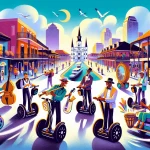New Orleans, a city intertwined with a diverse cultural fabric, has captivated visitors for centuries. With a unique blend of African, French, Spanish, and Caribbean influences, the city’s heritage is unparalleled in the United States.
In This Article
TL;DR
- New Orleans boasts a diverse cultural tapestry encompassing music, architecture, visual arts, literature, and cuisine.
- The city’s identity is shaped by historical landmarks like the French Quarter, Garden District, and Congo Square.
- The artistic landscape has been influenced by the convergence of African, European, and Caribbean cultures, giving birth to jazz, unique architectural styles, and a thriving arts community.
The Historical Landscape of New Orleans
Founded in 1718 by French colonists, New Orleans quickly became a melting pot of cultures due to its strategic location along the Mississippi River. The city’s early influences can be traced back to the French, Spanish, and African populations that settled in the area. Throughout its history, New Orleans has witnessed significant events that have shaped its character, including the Louisiana Purchase in 1803, the Battle of New Orleans in 1815, and the Civil War.
As a major port city, New Orleans played a crucial role in the growth of the American economy, particularly in the 19th century. The city’s unique position as a cultural crossroads has contributed to its enduring legacy as one of the most distinctive cities in the United States.
Architectural Heritage
New Orleans is celebrated for its iconic architectural styles, which reflect the city’s diverse historical influences. The French Quarter, also known as Vieux Carré, is the oldest neighborhood in the city and features a mix of Spanish, French, and Creole architecture. Visitors can admire the intricate ironwork balconies, colorful facades, and lush courtyards that define this historic district.
The Garden District, developed in the early 19th century, showcases grand antebellum mansions and stunning gardens. These architectural gems serve as a testament to the city’s prosperity during the plantation era.
Preservation efforts have been crucial in maintaining New Orleans’ architectural integrity. Organizations like the Preservation Resource Center and the Vieux Carré Commission work tirelessly to protect and restore the city’s historic buildings, ensuring that future generations can appreciate this unique architectural heritage.
Musical Roots and Evolution
New Orleans is widely regarded as the birthplace of jazz, a musical genre that emerged in the late 19th and early 20th centuries. Pioneering musicians like Buddy Bolden, Jelly Roll Morton, and Louis Armstrong laid the foundation for this improvisational and expressive art form, which drew from African rhythms, European harmonies, and American blues.
Over time, the city’s musical landscape has evolved to encompass a wide range of genres, including rhythm and blues, funk, hip-hop, and bounce music. The current music scene in New Orleans continues to reflect its historical influences, with local artists and venues keeping the city’s musical legacy alive.
Some notable music venues to experience the city’s vibrant music scene include:
- Preservation Hall (726 St Peter St, New Orleans, LA 70116; Open daily from 5 PM to 10 PM; Ticket prices vary)
- Tipitina’s (501 Napoleon Ave, New Orleans, LA 70115; Open for events; Check website for schedule and ticket prices)
- The Spotted Cat Music Club (623 Frenchmen St, New Orleans, LA 70116; Open daily from 2 PM to 2 AM; Cover charge varies)
Visual Arts and Artistic Movements
New Orleans has a rich history of visual arts, with a thriving community of artists and numerous art institutions. In the early 20th century, the French Quarter became a hub for artists, writers, and bohemians, who were drawn to the city’s unique atmosphere and creative energy.
Notable artists with ties to New Orleans include Edgar Degas, who spent several months in the city in the 1870s, and George Rodrigue, known for his iconic “Blue Dog” paintings. The New Orleans Museum of Art (NOMA), founded in 1911, houses an extensive collection of local and international art, showcasing the city’s artistic heritage.
- New Orleans Museum of Art (1 Collins Diboll Cir, New Orleans, LA 70124; Open Tue-Sun 10 AM to 5 PM, Closed Mon; Adults $15, Seniors/Students $10, Children 7-17 $8, Children 6 and under free)
Literary Contributions
New Orleans has been home to numerous notable authors and poets who have drawn inspiration from the city’s unique culture and history. Writers such as Tennessee Williams, William Faulkner, and Anne Rice have all left their mark on the literary landscape of New Orleans.
The city’s influence on American literature is undeniable, with its rich storytelling traditions and distinctive settings serving as a backdrop for countless works of fiction. Today, the contemporary literary scene in New Orleans continues to thrive, with local bookstores, writing workshops, and literary festivals celebrating the city’s enduring love affair with the written word.
Cultural Festivals and Events
New Orleans is famous for its vibrant cultural festivals and events that showcase the city’s heritage and traditions. Mardi Gras, the most well-known of these celebrations, attracts millions of visitors each year with its colorful parades, elaborate costumes, and lively atmosphere. The festival takes place on the day before the start of the Christian liturgical season of Lent, typically in February or early March.
Another major event is the New Orleans Jazz & Heritage Festival (Jazz Fest), which celebrates the city’s musical legacy and features a diverse lineup of local and international artists. The festival is held annually over two weekends in late April and early May at the Fair Grounds Race Course.
These festivals not only preserve and celebrate New Orleans’ cultural heritage but also have a significant economic and social impact on the local community, generating revenue for businesses and fostering a sense of pride and unity among residents.
Culinary Heritage
New Orleans is renowned for its distinctive Creole and Cajun cuisines, which have evolved from a blend of African, French, Spanish, and Native American influences. Signature dishes like gumbo, jambalaya, and red beans and rice showcase the city’s rich culinary heritage.
The city’s culinary scene is further enhanced by its many prominent restaurants and chefs who are dedicated to preserving traditional flavors while also innovating and pushing boundaries. Some notable restaurants that exemplify New Orleans’ culinary heritage include:
- Dooky Chase’s Restaurant (2301 Orleans Ave, New Orleans, LA 70119; Open Tue-Fri 11 AM to 3 PM; Entrees range from $15 to $25)
- Commander’s Palace (1403 Washington Ave, New Orleans, LA 70130; Open Mon-Fri 11:30 AM to 2 PM, 5:30 PM to 9 PM, Sat 11:30 AM to 1 PM, 5:30 PM to 9 PM, Sun 10:30 AM to 1:30 PM, 5:30 PM to 9 PM; Entrees range from $30 to $50)
- Galatoire’s Restaurant (209 Bourbon St, New Orleans, LA 70130; Open Tue-Sat 11:30 AM to 10 PM, Sun 12 PM to 10 PM; Entrees range from $25 to $45)
Preservation and Education
Preserving New Orleans’ cultural and historical heritage is a collaborative effort involving local organizations, educational institutions, and community members. Groups like the Preservation Resource Center, the Louisiana Landmarks Society, and the Historic New Orleans Collection work tirelessly to protect and promote the city’s unique heritage.
Educational institutions, such as the University of New Orleans and Tulane University, also play a crucial role in preserving and studying the city’s history and culture. These institutions offer courses, workshops, and public programs that engage the community and foster a deeper understanding and appreciation of New Orleans’ heritage.
Community involvement is essential in ensuring the longevity and vitality of the city’s cultural heritage. By participating in festivals, supporting local artists and businesses, and advocating for preservation efforts, residents and visitors alike can contribute to the ongoing celebration and protection of New Orleans’ unique identity.
Engaging with New Orleans’ Heritage Today
There are numerous ways for locals and tourists to experience and engage with New Orleans’ rich heritage. Visitors can explore the city’s historic neighborhoods, such as the French Quarter and Garden District, on guided tours or self-guided walks. Many local organizations offer educational programs, workshops, and events that provide insights into the city’s history, music, art, and cuisine.
When engaging with cultural sites and events, it is essential to do so respectfully and sustainably. Visitors should be mindful of the impact their actions have on the local community and strive to support local businesses and artists. By participating in community events, such as second-line parades and neighborhood festivals, visitors can gain a deeper appreciation for the city’s vibrant culture and traditions.
New Orleans’ heritage is a living, breathing entity that continues to evolve and shape the city’s identity. By embracing its past, celebrating its present, and preserving its legacy for future generations, New Orleans remains a beacon of cultural richness and resilience, inviting all who visit to experience its magic and charm.






